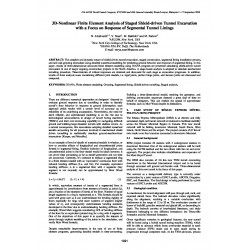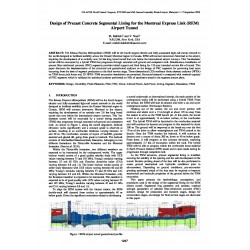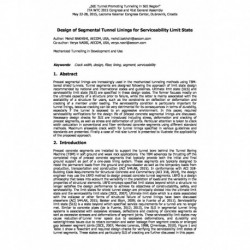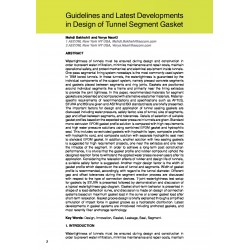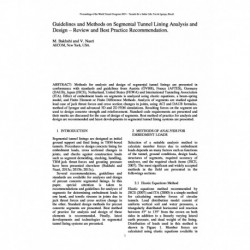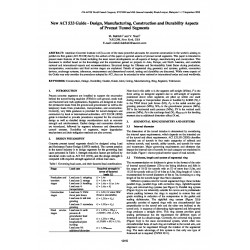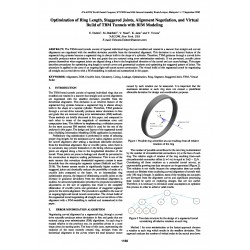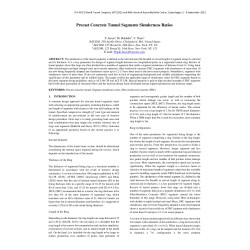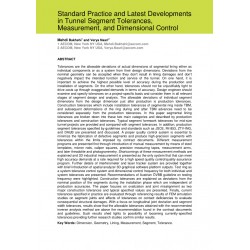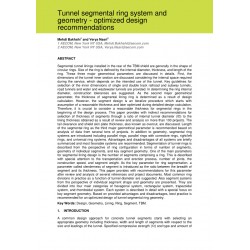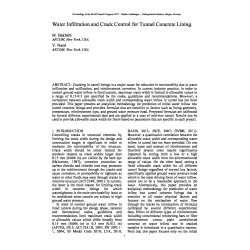No document
Search & filter
Search for a publication
Search & filter
List of products by author: M. Bakhshi
-
3D-Nonlinear Finite Element Analysis of Staged Shield-driven Tunnel Excavation with a Focus on Response of Segmental...
Abstract: The complex and dynamic nature of shield-driven tunnel excavation, staged construction, segmental lining installation process, and tail-void grouting necessitate using detailed numerical modeling for predicting ground behavior and response of segmental lining. In this paper, results of three-dimensional advanced finite element modeling using DIANA program are presented simulating shield-driven...
0,00 € -
Design of Precast Concrete Segmental Lining for the Montreal Express Link (REM) Airport Tunnel
Abstract: The Réseau Express Métropolitain (REM) will be the fourth largest electric and fully-automated light-rail transit network in the world designed to facilitate mobility across the Greater Montreal region in Canada. REM will connect downtown Montreal to the airport, requiring the development of an entirely new 3.6 km long bored tunnel that runs below the international airport runways. This...
0,00 € -
Design of Segmental Tunnel Linings for Serviceability Limit State
Abstract: Precast segmental linings are increasingly used in the mechanized tunneling methods using TBM- bored shield tunnels. Tunnel segments are designed following the approach of limit state design recommended by national and international codes and guidelines. Ultimate limit state (ULS) and serviceability limit state (SLS) are specified in these design codes. The former focuses mostly on the ultimate...
0,00 € -
Guidelines and Latest Developments in Design of Tunnel Segment Gasket
Abstract: Watertightness of tunnels must be ensured during design and construction in order to prevent water infiltration, minimize maintenance and repair costs, maintain operational safety, and protect mechanical and electrical equipment inside tunnels. One-pass segmental lining system nowadays is the most commonly-used system in TBM bored tunnels. In these tunnels, the watertightness is guaranteed by...
0,00 € -
Guidelines and Methods on Segmental Tunnel Lining Analysis andDesign – Review and Best Practice Recommendation
Abstract: Methods for analysis and design of segmental tunnel linings are presented inconformance with standards and guidelines from Austria (ÖVBB), France (AFTES), Germany(DAUB), Japan (JSCE), Netherland, United States (FHWA) and International Tunneling Association(ITA). Effect of embedment loads on segments is analyzed using elastic equations, a beam-springmodel, and Finite Element or Finite Difference...
0,00 € -
New ACI 533 Guide - Design, Manufacturing, Construction and Durability Aspects of Precast Tunnel Segments
Abstract: American Concrete Institute (ACI) as one of the most powerful advocates for concrete construction in the world is aiming to publish its first guide (ACI 533.5R) led by the authors of this paper on general aspects of precast tunnel segments. This paper is intended to present main features of the Guide including the most recent developments on all aspects of design, manufacturing and...
0,00 € -
Optimization of Ring Length, Staggered Joints, Alignment Negotiation, and Virtual Build of TBM Tunnels with BIM Modeling
Abstract: The TBM-bored tunnels consist of tapered individual rings that are installed and rotated in a manner that straight and curved alignments are negotiated with the smallest deviation possible from the theoretical alignment. This deviation is an inherent feature of the segmental ring systems because a segmental ring is always built in the shape of a cylinder. Therefore, TBM guidance through a...
0,00 € -
Precast Concrete Tunnel Segments Slenderness Ratios
Abstract: The slenderness of the tunnel segments is defined as the ratio between the breadth or curved length of segment along its centroid and its thickness. It is a key parameter for design of segment length between two longitudinal joints in a segmental tunnel ring. Review of tunnel projects show that rings are often divided into a number of segments that yields a segment slenderness of between 8 and...
0,00 € -
Standard Practice and Latest Developments in Tunnel Segment Tolerances, Measurement, and Dimensional Control
Abstract: Tolerances are the allowable deviations of actual dimensions of segmental lining either as individual components or as a system from their design dimensions. Deviations from the nominal geometry can be accepted when they don’t result in lining damages and don’t negatively impact the intended function and service of the tunnel. On one hand, it is important to achieve the highest possible level...
0,00 € -
Tunnel segmental ring system and geometry - optimized design recommendations
Abstract: Segmental tunnel linings installed in the rear of the TBM shield are generally in the shape of circular rings. Size of the ring is defined by the internal diameter, thickness, and length of the ring. These three major geometrical parameters are discussed in details. First, the dimensions of the tunnel inner section are discussed considering the internal space required during the service, which...
0,00 € -
Water Infiltration and Crack Control for Tunnel Concrete Lining
Abstract: Cracking in tunnel linings is a major cause for reduction in serviceability due to water infiltration and exfiltration, and reinforcement corrosion. In current industry practice, in order to control ground water inflow in lined tunnels, maximum crack width is limited to allowable values in a range of 0.15-0.3 mm specified by the codes, guidelines and recommendations. However, a correlation...
0,00 €

